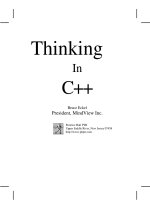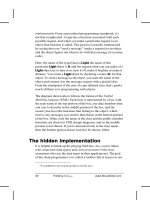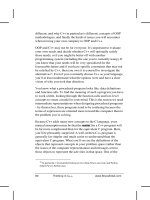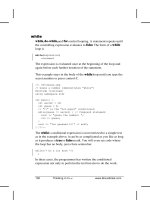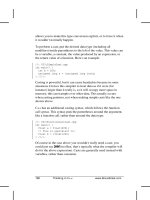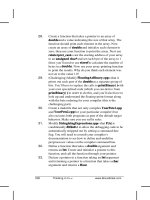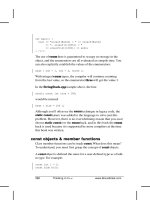Thinking in C plus plus (P21) doc
Bạn đang xem bản rút gọn của tài liệu. Xem và tải ngay bản đầy đủ của tài liệu tại đây (151.68 KB, 50 trang )
Chapter 14: Templates & Container Classes
101
: str(s, 0, width) {}
friend ostream&
operator<<(ostream& os, Fixw& fw) {
return os << fw.str;
}
};
typedef unsigned long ulong;
// Print a number in binary:
class Bin {
ulong n;
public:
Bin(ulong nn) { n = nn; }
friend ostream& operator<<(ostream&, Bin&);
};
ostream& operator<<(ostream& os, Bin& b) {
ulong bit = ~(ULONG_MAX >> 1); // Top bit set
while(bit) {
os << (b.n & bit ? '1' : '0');
bit >>= 1;
}
return os;
}
int main() {
char* string =
"Things that make us happy, make us wise";
for(int i = 1; i <= strlen(string); i++)
cout << Fixw(string, i) << endl;
ulong x = 0xCAFEBABEUL;
ulong y = 0x76543210UL;
cout << "x in binary: " << Bin(x) << endl;
cout << "y in binary: " << Bin(y) << endl;
} ///:~
The constructor for
Fixw
creates a shortened copy of its
char*
argument, and the destructor
releases the memory created for this copy. The overloaded
operator<<
takes the contents of
its second argument, the
Fixw
object, and inserts it into the first argument, the
ostream
, then
returns the
ostream
so it can be used in a chained expression. When you use
Fixw
in an
expression like this:
cout << Fixw(string, i) << endl;
Chapter 14: Templates & Container Classes
102
a
temporary object
is created by the call to the
Fixw
constructor, and that temporary is passed
to
operator<<
. The effect is that of a manipulator with arguments.
The
Bin
effector relies on the fact that shifting an unsigned number to the right shifts zeros
into the high bits. ULONG_MAX (the largest
unsigned long
value, from the standard include
file
<climits>
) is used to produce a value with the high bit set, and this value is moved across
the number in question (by shifting it), masking each bit.
Initially the problem with this technique was that once you created a class called
Fixw
for
char*
or
Bin
for
unsigned long
,
no one else could create a different
Fixw
or
Bin
class for
their type. However, with
namespaces
(covered in Chapter XX), this problem is eliminated.
Iostream examples
In this section you’ll see some examples of what you can do with all the information you’ve
learned in this chapter. Although many tools exist to manipulate bytes (stream editors like
sed
and
awk
from Unix are perhaps the most well known, but a text editor also fits this category),
they generally have some limitations.
sed
and
awk
can be slow and can only handle lines in a
forward sequence, and text editors usually require human interaction, or at least learning a
proprietary macro language. The programs you write with iostreams have none of these
limitations: They’re fast, portable, and flexible. It’s a very useful tool to have in your kit.
Code generation
The first examples concern the generation of programs that, coincidentally, fit the format used
in this book. This provides a little extra speed and consistency when developing code. The
first program creates a file to hold
main( )
(assuming it takes no command-line arguments and
uses the iostream library):
//: C02:Makemain.cpp
// Create a shell main() file
#include " /require.h"
#include <fstream>
#include <strstream>
#include <cstring>
#include <cctype>
using namespace std;
int main(int argc, char* argv[]) {
requireArgs(argc, 1);
ofstream mainfile(argv[1]);
assure(mainfile, argv[1]);
istrstream name(argv[1]);
ostrstream CAPname;
Chapter 14: Templates & Container Classes
103
char c;
while(name.get(c))
CAPname << char(toupper(c));
CAPname << ends;
mainfile << "//" << ": " << CAPname.rdbuf()
<< " " << endl
<< "#include <iostream>" << endl
<< endl
<< "main() {" << endl << endl
<< "}" << endl;
} ///:~
The argument on the command line is used to create an
istrstream
, so the characters can be
extracted one at a time and converted to upper case with the Standard C library macro
toupper( )
. This returns an
int
so it must be explicitly cast to a
char
. This name is used in the
headline, followed by the remainder of the generated file.
Maintaining class library source
The second example performs a more complex and useful task. Generally, when you create a
class you think in library terms, and make a header file
Name.h
for the class declaration and a
file where the member functions are implemented, called
Name.cpp
. These files have certain
requirements: a particular coding standard (the program shown here will use the coding
format for this book), and in the header file the declarations are generally surrounded by some
preprocessor statements to prevent multiple declarations of classes. (Multiple declarations
confuse the compiler – it doesn’t know which one you want to use. They could be different,
so it throws up its hands and gives an error message.)
This example allows you to create a new header-implementation pair of files, or to modify an
existing pair. If the files already exist, it checks and potentially modifies the files, but if they
don’t exist, it creates them using the proper format.
[[ This should be changed to use
string
instead of <cstring> ]]
//: C02:Cppcheck.cpp
// Configures .h & .cpp files
// To conform to style standard.
// Tests existing files for conformance
#include " /require.h"
#include <fstream>
#include <strstream>
#include <cstring>
#include <cctype>
using namespace std;
int main(int argc, char* argv[]) {
Chapter 14: Templates & Container Classes
104
const int sz = 40; // Buffer sizes
const int bsz = 100;
requireArgs(argc, 1); // File set name
enum bufs { base, header, implement,
Hline1, guard1, guard2, guard3,
CPPline1, include, bufnum };
char b[bufnum][sz];
ostrstream osarray[] = {
ostrstream(b[base], sz),
ostrstream(b[header], sz),
ostrstream(b[implement], sz),
ostrstream(b[Hline1], sz),
ostrstream(b[guard1], sz),
ostrstream(b[guard2], sz),
ostrstream(b[guard3], sz),
ostrstream(b[CPPline1], sz),
ostrstream(b[include], sz),
};
osarray[base] << argv[1] << ends;
// Find any '.' in the string using the
// Standard C library function strchr():
char* period = strchr(b[base], '.');
if(period) *period = 0; // Strip extension
// Force to upper case:
for(int i = 0; b[base][i]; i++)
b[base][i] = toupper(b[base][i]);
// Create file names and internal lines:
osarray[header] << b[base] << ".h" << ends;
osarray[implement] << b[base] << ".cpp" << ends;
osarray[Hline1] << "//" << ": " << b[header]
<< " " << ends;
osarray[guard1] << "#ifndef " << b[base]
<< "_H" << ends;
osarray[guard2] << "#define " << b[base]
<< "_H" << ends;
osarray[guard3] << "#endif // " << b[base]
<< "_H" << ends;
osarray[CPPline1] << "//" << ": "
<< b[implement]
<< " " << ends;
osarray[include] << "#include \""
<< b[header] << "\"" <<ends;
// First, try to open existing files:
Chapter 14: Templates & Container Classes
105
ifstream existh(b[header]),
existcpp(b[implement]);
if(!existh) { // Doesn't exist; create it
ofstream newheader(b[header]);
assure(newheader, b[header]);
newheader << b[Hline1] << endl
<< b[guard1] << endl
<< b[guard2] << endl << endl
<< b[guard3] << endl;
}
if(!existcpp) { // Create cpp file
ofstream newcpp(b[implement]);
assure(newcpp, b[implement]);
newcpp << b[CPPline1] << endl
<< b[include] << endl;
}
if(existh) { // Already exists; verify it
strstream hfile; // Write & read
ostrstream newheader; // Write
hfile << existh.rdbuf() << ends;
// Check that first line conforms:
char buf[bsz];
if(hfile.getline(buf, bsz)) {
if(!strstr(buf, "//" ":") ||
!strstr(buf, b[header]))
newheader << b[Hline1] << endl;
}
// Ensure guard lines are in header:
if(!strstr(hfile.str(), b[guard1]) ||
!strstr(hfile.str(), b[guard2]) ||
!strstr(hfile.str(), b[guard3])) {
newheader << b[guard1] << endl
<< b[guard2] << endl
<< buf
<< hfile.rdbuf() << endl
<< b[guard3] << endl << ends;
} else
newheader << buf
<< hfile.rdbuf() << ends;
// If there were changes, overwrite file:
if(strcmp(hfile.str(),newheader.str())!=0){
existh.close();
ofstream newH(b[header]);
Chapter 14: Templates & Container Classes
106
assure(newH, b[header]);
newH << "//@//" << endl // Change marker
<< newheader.rdbuf();
}
delete hfile.str();
delete newheader.str();
}
if(existcpp) { // Already exists; verify it
strstream cppfile;
ostrstream newcpp;
cppfile << existcpp.rdbuf() << ends;
char buf[bsz];
// Check that first line conforms:
if(cppfile.getline(buf, bsz))
if(!strstr(buf, "//" ":") ||
!strstr(buf, b[implement]))
newcpp << b[CPPline1] << endl;
// Ensure header is included:
if(!strstr(cppfile.str(), b[include]))
newcpp << b[include] << endl;
// Put in the rest of the file:
newcpp << buf << endl; // First line read
newcpp << cppfile.rdbuf() << ends;
// If there were changes, overwrite file:
if(strcmp(cppfile.str(),newcpp.str())!=0){
existcpp.close();
ofstream newCPP(b[implement]);
assure(newCPP, b[implement]);
newCPP << "//@//" << endl // Change marker
<< newcpp.rdbuf();
}
delete cppfile.str();
delete newcpp.str();
}
} ///:~
This example requires a lot of string formatting in many different buffers. Rather than
creating a lot of individually named buffers and
ostrstream
objects, a single set of names is
created in the
enum
bufs
. Then two arrays are created: an array of character buffers and an
array of
ostrstream
objects built from those character buffers. Note that in the definition for
the two-dimensional array of
char
buffers
b
, the number of
char
arrays is determined by
bufnum
, the last enumerator in
bufs
. When you create an enumeration, the compiler assigns
integral values to all the
enum
labels starting at zero, so the sole purpose of
bufnum
is to be a
counter for the number of enumerators in
buf
. The length of each string in
b
is
sz
.
Chapter 14: Templates & Container Classes
107
The names in the enumeration are
base
, the capitalized base file name without extension;
header
, the header file name;
implement
, the implementation file (
cpp
) name;
Hline1
, the
skeleton first line of the header file;
guard1
,
guard2
, and
guard3
, the “guard” lines in the
header file (to prevent multiple inclusion);
CPPline1
, the skeleton first line of the
cpp
file;
and
include
, the line in the
cpp
file that includes the header file.
osarray
is an array of
ostrstream
objects created using aggregate initialization and automatic
counting. Of course, this is the form of the
ostrstream
constructor that takes two arguments
(the buffer address and buffer size), so the constructor calls must be formed accordingly
inside the aggregate initializer list. Using the
bufs
enumerators, the appropriate array element
of
b
is tied to the corresponding
osarray
object. Once the array is created, the objects in the
array can be selected using the enumerators, and the effect is to fill the corresponding
b
element. You can see how each string is built in the lines following the
ostrstream
array
definition.
Once the strings have been created, the program attempts to open existing versions of both the
header and
cpp
file as
ifstream
s. If you test the object using the operator ‘
!
’ and the file
doesn’t exist, the test will fail. If the header or implementation file doesn’t exist, it is created
using the appropriate lines of text built earlier.
If the files
do
exist, then they are verified to ensure the proper format is followed. In both
cases, a
strstream
is created and the whole file is read in; then the first line is read and
checked to make sure it follows the format by seeing if it contains both a “
//:
” and the name of
the file. This is accomplished with the Standard C library function
strstr( )
. If the first line
doesn’t conform, the one created earlier is inserted into an
ostrstream
that has been created to
hold the edited file.
In the header file, the whole file is searched (again using
strstr( )
) to ensure it contains the
three “guard” lines; if not, they are inserted. The implementation file is checked for the
existence of the line that includes the header file (although the compiler effectively guarantees
its existence).
In both cases, the original file (in its
strstream
) and the edited file (in the
ostrstream
) are
compared to see if there are any changes. If there are, the existing file is closed, and a new
ofstream
object is created to overwrite it. The
ostrstream
is output to the file after a special
change marker is added at the beginning, so you can use a text search program to rapidly find
any files that need reviewing to make additional changes.
Detecting compiler errors
All the code in this book is designed to compile as shown without errors. Any line of code
that should generate a compile-time error is commented out with the special comment
sequence “//!”. The following program will remove these special comments and append a
numbered comment to the line, so that when you run your compiler it should generate error
messages and you should see all the numbers appear when you compile all the files. It also
appends the modified line to a special file so you can easily locate any lines that don’t
generate errors:
Chapter 14: Templates & Container Classes
108
//: C02:Showerr.cpp
// Un-comment error generators
#include " /require.h"
#include <iostream>
#include <fstream>
#include <strstream>
#include <cctype>
#include <cstring>
using namespace std;
char* marker = "//!";
char* usage =
"usage: showerr filename chapnum\n"
"where filename is a C++ source file\n"
"and chapnum is the chapter name it's in.\n"
"Finds lines commented with //! and removes\n"
"comment, appending //(#) where # is unique\n"
"across all files, so you can determine\n"
"if your compiler finds the error.\n"
"showerr /r\n"
"resets the unique counter.";
// File containing error number counter:
char* errnum = " /errnum.txt";
// File containing error lines:
char* errfile = " /errlines.txt";
ofstream errlines(errfile,ios::app);
int main(int argc, char* argv[]) {
requireArgs(argc, 2, usage);
if(argv[1][0] == '/' || argv[1][0] == '-') {
// Allow for other switches:
switch(argv[1][1]) {
case 'r': case 'R':
cout << "reset counter" << endl;
remove(errnum); // Delete files
remove(errfile);
return 0;
default:
cerr << usage << endl;
return 1;
}
}
Chapter 14: Templates & Container Classes
109
char* chapter = argv[2];
strstream edited; // Edited file
int counter = 0;
{
ifstream infile(argv[1]);
assure(infile, argv[1]);
ifstream count(errnum);
assure(count, errnum);
if(count) count >> counter;
int linecount = 0;
const int sz = 255;
char buf[sz];
while(infile.getline(buf, sz)) {
linecount++;
// Eat white space:
int i = 0;
while(isspace(buf[i]))
i++;
// Find marker at start of line:
if(strstr(&buf[i], marker) == &buf[i]) {
// Erase marker:
memset(&buf[i], ' ', strlen(marker));
// Append counter & error info:
ostrstream out(buf, sz, ios::ate);
out << "//(" << ++counter << ") "
<< "Chapter " << chapter
<< " File: " << argv[1]
<< " Line " << linecount << endl
<< ends;
edited << buf;
errlines << buf; // Append error file
} else
edited << buf << "\n"; // Just copy
}
} // Closes files
ofstream outfile(argv[1]); // Overwrites
assure(outfile, argv[1]);
outfile << edited.rdbuf();
ofstream count(errnum); // Overwrites
assure(count, errnum);
count << counter; // Save new counter
} ///:~
Chapter 14: Templates & Container Classes
110
The marker can be replaced with one of your choice.
Each file is read a line at a time, and each line is searched for the marker appearing at the head
of the line; the line is modified and put into the error line list and into the
strstream
edited
.
When the whole file is processed, it is closed (by reaching the end of a scope), reopened as an
output file and
edited
is poured into the file. Also notice the counter is saved in an external
file, so the next time this program is invoked it continues to sequence the counter.
A simple datalogger
This example shows an approach you might take to log data to disk and later retrieve it for
processing. The example is meant to produce a temperature-depth profile of the ocean at
various points. To hold the data, a class is used:
//: C02:DataLogger.h
// Datalogger record layout
#ifndef DATALOG_H
#define DATALOG_H
#include <ctime>
#include <iostream>
class DataPoint {
std::tm time; // Time & day
static const int bsz = 10;
// Ascii degrees (*) minutes (') seconds ("):
char latitude[bsz], longitude[bsz];
double depth, temperature;
public:
std::tm getTime();
void setTime(std::tm t);
const char* getLatitude();
void setLatitude(const char* l);
const char* getLongitude();
void setLongitude(const char* l);
double getDepth();
void setDepth(double d);
double getTemperature();
void setTemperature(double t);
void print(std::ostream& os);
};
#endif // DATALOG_H ///:~
The access functions provide controlled reading and writing to each of the data members. The
print( )
function formats the
DataPoint
in a readable form onto an
ostream
object (the
argument to
print( )
). Here’s the definition file:
Chapter 14: Templates & Container Classes
111
//: C02:Datalog.cpp {O}
// Datapoint member functions
#include "DataLogger.h"
#include <iomanip>
#include <cstring>
using namespace std;
tm DataPoint::getTime() { return time; }
void DataPoint::setTime(tm t) { time = t; }
const char* DataPoint::getLatitude() {
return latitude;
}
void DataPoint::setLatitude(const char* l) {
latitude[bsz - 1] = 0;
strncpy(latitude, l, bsz - 1);
}
const char* DataPoint::getLongitude() {
return longitude;
}
void DataPoint::setLongitude(const char* l) {
longitude[bsz - 1] = 0;
strncpy(longitude, l, bsz - 1);
}
double DataPoint::getDepth() { return depth; }
void DataPoint::setDepth(double d) { depth = d; }
double DataPoint::getTemperature() {
return temperature;
}
void DataPoint::setTemperature(double t) {
temperature = t;
}
void DataPoint::print(ostream& os) {
os.setf(ios::fixed, ios::floatfield);
Chapter 14: Templates & Container Classes
112
os.precision(4);
os.fill('0'); // Pad on left with '0'
os << setw(2) << getTime().tm_mon << '\\'
<< setw(2) << getTime().tm_mday << '\\'
<< setw(2) << getTime().tm_year << ' '
<< setw(2) << getTime().tm_hour << ':'
<< setw(2) << getTime().tm_min << ':'
<< setw(2) << getTime().tm_sec;
os.fill(' '); // Pad on left with ' '
os << " Lat:" << setw(9) << getLatitude()
<< ", Long:" << setw(9) << getLongitude()
<< ", depth:" << setw(9) << getDepth()
<< ", temp:" << setw(9) << getTemperature()
<< endl;
} ///:~
In
print( )
, the call to
setf( )
causes the floating-point output to be fixed-precision, and
precision( )
sets the number of decimal places to four.
The default is to right-justify the data within the field. The time information consists of two
digits each for the hours, minutes and seconds, so the width is set to two with
setw( )
in each
case. (Remember that any changes to the field width affect only the next output operation, so
setw( )
must be given for each output.) But first, to put a zero in the left position if the value is
less than 10, the fill character is set to ‘0’. Afterwards, it is set back to a space.
The latitude and longitude are zero-terminated character fields, which hold the information as
degrees (here, ‘*’ denotes degrees), minutes (‘), and seconds(“). You can certainly devise a
more efficient storage layout for latitude and longitude if you desire.
Generating test data
Here’s a program that creates a file of test data in binary form (using
write( )
) and a second
file in ASCII form using
DataPoint::print( )
. You can also print it out to the screen but it’s
easier to inspect in file form.
//: C02:Datagen.cpp
//{L} Datalog
// Test data generator
#include "DataLogger.h"
#include " /require.h"
#include <fstream>
#include <cstdlib>
#include <cstring>
using namespace std;
int main() {
Chapter 14: Templates & Container Classes
113
ofstream data("data.txt");
assure(data, "data.txt");
ofstream bindata("data.bin", ios::binary);
assure(bindata, "data.bin");
time_t timer;
// Seed random number generator:
srand(time(&timer));
for(int i = 0; i < 100; i++) {
DataPoint d;
// Convert date/time to a structure:
d.setTime(*localtime(&timer));
timer += 55; // Reading each 55 seconds
d.setLatitude("45*20'31\"");
d.setLongitude("22*34'18\"");
// Zero to 199 meters:
double newdepth = rand() % 200;
double fraction = rand() % 100 + 1;
newdepth += double(1) / fraction;
d.setDepth(newdepth);
double newtemp = 150 + rand()%200; // Kelvin
fraction = rand() % 100 + 1;
newtemp += (double)1 / fraction;
d.setTemperature(newtemp);
d.print(data);
bindata.write((unsigned char*)&d,
sizeof(d));
}
} ///:~
The file DATA.TXT is created in the ordinary way as an ASCII file, but DATA.BIN has the
flag
ios::binary
to tell the constructor to set it up as a binary file.
The Standard C library function
time( )
, when called with a zero argument, returns the current
time as a
time_t
value, which is the number of seconds elapsed since 00:00:00 GMT, January
1 1970 (the dawning of the age of Aquarius?). The current time is the most convenient way to
seed the random number generator with the Standard C library function
srand( )
, as is done
here.
Sometimes a more convenient way to store the time is as a
tm
structure, which has all the
elements of the time and date broken up into their constituent parts as follows:
struct tm {
int tm_sec; // 0-59 seconds
int tm_min; // 0-59 minutes
int tm_hour; // 0-23 hours
Chapter 14: Templates & Container Classes
114
int tm_mday; // Day of month
int tm_mon; // 0-11 months
int tm_year; // Calendar year
int tm_wday; // Sunday == 0, etc.
int tm_yday; // 0-365 day of year
int tm_isdst; // Daylight savings?
};
To convert from the time in seconds to the local time in the
tm
format, you use the Standard
C library
localtime( )
function, which takes the number of seconds and returns a pointer to the
resulting
tm
. This
tm
, however, is a
static
structure inside the
localtime( )
function, which is
rewritten every time
localtime( )
is called. To copy the contents into the
tm
struct
inside
DataPoint
, you might think you must copy each element individually. However, all you must
do is a structure assignment, and the compiler will take care of the rest. This means the right-
hand side must be a structure, not a pointer, so the result of
localtime( )
is dereferenced. The
desired result is achieved with
d.setTime(*localtime(&timer));
After this, the
timer
is incremented by 55 seconds to give an interesting interval between
readings.
The latitude and longitude used are fixed values to indicate a set of readings at a single
location. Both the depth and the temperature are generated with the Standard C library
rand( )
function, which returns a pseudorandom number between zero and the constant
RAND_MAX. To put this in a desired range, use the modulus operator
%
and the upper end
of the range. These numbers are integral; to add a fractional part, a second call to
rand( )
is
made, and the value is inverted after adding one (to prevent divide-by-zero errors).
In effect, the DATA.BIN file is being used as a container for the data in the program, even
though the container exists on disk and not in RAM. To send the data out to the disk in binary
form,
write( )
is used. The first argument is the starting address of the source block – notice it
must be cast to an
unsigned char*
because that’s what the function expects. The second
argument is the number of bytes to write, which is the size of the
DataPoint
object. Because
no pointers are contained in
DataPoint
, there is no problem in writing the object to disk. If
the object is more sophisticated, you must implement a scheme for
serialization
. (Most
vendor class libraries have some sort of serialization structure built into them.)
Verifying & viewing the data
To check the validity of the data stored in binary format, it is read from the disk and put in
text form in DATA2.TXT, so that file can be compared to DATA.TXT for verification. In the
following program, you can see how simple this data recovery is. After the test file is created,
the records are read at the command of the user.
//: C02:Datascan.cpp
//{L} Datalog
// Verify and view logged data
Chapter 14: Templates & Container Classes
115
#include "DataLogger.h"
#include " /require.h"
#include <iostream>
#include <fstream>
#include <strstream>
#include <iomanip>
using namespace std;
int main() {
ifstream bindata("data.bin", ios::binary);
assure(bindata, "data.bin");
// Create comparison file to verify data.txt:
ofstream verify("data2.txt");
assure(verify, "data2.txt");
DataPoint d;
while(bindata.read(
(unsigned char*)&d, sizeof d))
d.print(verify);
bindata.clear(); // Reset state to "good"
// Display user-selected records:
int recnum = 0;
// Left-align everything:
cout.setf(ios::left, ios::adjustfield);
// Fixed precision of 4 decimal places:
cout.setf(ios::fixed, ios::floatfield);
cout.precision(4);
for(;;) {
bindata.seekg(recnum* sizeof d, ios::beg);
cout << "record " << recnum << endl;
if(bindata.read(
(unsigned char*)&d, sizeof d)) {
cout << asctime(&(d.getTime()));
cout << setw(11) << "Latitude"
<< setw(11) << "Longitude"
<< setw(10) << "Depth"
<< setw(12) << "Temperature"
<< endl;
// Put a line after the description:
cout << setfill('-') << setw(43) << '-'
<< setfill(' ') << endl;
cout << setw(11) << d.getLatitude()
<< setw(11) << d.getLongitude()
<< setw(10) << d.getDepth()
Chapter 14: Templates & Container Classes
116
<< setw(12) << d.getTemperature()
<< endl;
} else {
cout << "invalid record number" << endl;
bindata.clear(); // Reset state to "good"
}
cout << endl
<< "enter record number, x to quit:";
char buf[10];
cin.getline(buf, 10);
if(buf[0] == 'x') break;
istrstream input(buf, 10);
input >> recnum;
}
} ///:~
The
ifstream
bindata
is created from DATA.BIN as a binary file, with the
ios::nocreate
flag
on to cause the
assert( )
to fail if the file doesn’t exist. The
read( )
statement reads a single
record and places it directly into the
DataPoint d
. (Again, if
DataPoint
contained pointers
this would result in meaningless pointer values.) This
read( )
action will set
bindata
’s
failbit
when the end of the file is reached, which will cause the
while
statement to fail. At this point,
however, you can’t move the get pointer back and read more records because the state of the
stream won’t allow further reads. So the
clear( )
function is called to reset the
failbit
.
Once the record is read in from disk, you can do anything you want with it, such as perform
calculations or make graphs. Here, it is displayed to further exercise your knowledge of
iostream formatting.
The rest of the program displays a record number (represented by
recnum
) selected by the
user. As before, the precision is fixed at four decimal places, but this time everything is left
justified.
The formatting of this output looks different from before:
record 0
Tue Nov 16 18:15:49 1993
Latitude Longitude Depth Temperature
45*20'31" 22*34'18" 186.0172 269.0167
To make sure the labels and the data columns line up, the labels are put in the same width
fields as the columns, using
setw( )
. The line in between is generated by setting the fill
character to ‘-’, the width to the desired line width, and outputting a single ‘-’.
If the
read( )
fails, you’ll end up in the
else
part, which tells the user the record number was
invalid. Then, because the
failbit
was set, it must be reset with a call to
clear( )
so the next
read( )
is successful (assuming it’s in the right range).
Chapter 14: Templates & Container Classes
117
Of course, you can also open the binary data file for writing as well as reading. This way you
can retrieve the records, modify them, and write them back to the same location, thus creating
a flat-file database management system. In my very first programming job, I also had to create
a flat-file DBMS – but using BASIC on an Apple II. It took months, while this took minutes.
Of course, it might make more sense to use a packaged DBMS now, but with C++ and
iostreams you can still do all the low-level operations that are necessary in a lab.
Counting editor
Often you have some editing task where you must go through and sequentially number
something, but all the other text is duplicated. I encountered this problem when pasting digital
photos into a Web page – I got the formatting just right, then duplicated it, then had the
problem of incrementing the photo number for each one. So I replaced the photo number with
XXX, duplicated that, and wrote the following program to find and replace the “XXX” with
an incremented count. Notice the formatting, so the value will be “001,” “002,” etc.:
//: C02:NumberPhotos.cpp
// Find the marker "XXX" and replace it with an
// incrementing number whereever it appears. Used
// to help format a web page with photos in it
#include " /require.h"
#include <fstream>
#include <sstream>
#include <iomanip>
#include <string>
using namespace std;
int main(int argc, char* argv[]) {
requireArgs(argc, 2);
ifstream in(argv[1]);
assure(in, argv[1]);
ofstream out(argv[2]);
assure(out, argv[2]);
string line;
int counter = 1;
while(getline(in, line)) {
int xxx = line.find("XXX");
if(xxx != string::npos) {
ostringstream cntr;
cntr << setfill('0') << setw(3) << counter++;
line.replace(xxx, 3, cntr.str());
}
out << line << endl;
}
Chapter 14: Templates & Container Classes
118
} ///:~
Breaking up big files
This program was created to break up big files into smaller ones, in particular so they could
be more easily downloaded from an Internet server (since hangups sometimes occur, this
allows someone to download a file a piece at a time and then re-assemble it at the client end).
You’ll note that the program also creates a reassembly batch file for DOS (where it is
messier), whereas under Linux/Unix you simply say something like “
cat *piece* >
destination.file
”.
This program reads the entire file into memory, which of course relies on having a 32-bit
operating system with virtual memory for big files. It then pieces it out in chunks to the
smaller files, generating the names as it goes. Of course, you can come up with a possibly
more reasonable strategy that reads a chunk, creates a file, reads another chunk, etc.
Note that this program can be run on the server, so you only have to download the big file
once and then break it up once it’s on the server.
//: C02:Breakup.cpp
// Breaks a file up into smaller files for
// easier downloads
#include " /require.h"
#include <iostream>
#include <fstream>
#include <iomanip>
#include <strstream>
#include <string>
using namespace std;
int main(int argc, char* argv[]) {
requireArgs(argc, 1);
ifstream in(argv[1], ios::binary);
assure(in, argv[1]);
in.seekg(0, ios::end); // End of file
long fileSize = in.tellg(); // Size of file
cout << "file size = " << fileSize << endl;
in.seekg(0, ios::beg); // Start of file
char* fbuf = new char[fileSize];
require(fbuf != 0);
in.read(fbuf, fileSize);
in.close();
string infile(argv[1]);
Chapter 14: Templates & Container Classes
119
int dot = infile.find('.');
while(dot != string::npos) {
infile.replace(dot, 1, "-");
dot = infile.find('.');
}
string batchName(
"DOSAssemble" + infile + ".bat");
ofstream batchFile(batchName.c_str());
batchFile << "copy /b ";
int filecount = 0;
const int sbufsz = 128;
char sbuf[sbufsz];
const long pieceSize = 1000L * 100L;
long byteCounter = 0;
while(byteCounter < fileSize) {
ostrstream name(sbuf, sbufsz);
name << argv[1] << "-part" << setfill('0')
<< setw(2) << filecount++ << ends;
cout << "creating " << sbuf << endl;
if(filecount > 1)
batchFile << "+";
batchFile << sbuf;
ofstream out(sbuf, ios::out | ios::binary);
assure(out, sbuf);
long byteq;
if(byteCounter + pieceSize < fileSize)
byteq = pieceSize;
else
byteq = fileSize - byteCounter;
out.write(fbuf + byteCounter, byteq);
cout << "wrote " << byteq << " bytes, ";
byteCounter += byteq;
out.close();
cout << "ByteCounter = " << byteCounter
<< ", fileSize = " << fileSize << endl;
}
batchFile << " " << argv[1] << endl;
} ///:~
Chapter 14: Templates & Container Classes
120
Summary
This chapter has given you a fairly thorough introduction to the iostream class library. In all
likelihood, it is all you need to create programs using iostreams. (In later chapters you’ll see
simple examples of adding iostream functionality to your own classes.) However, you should
be aware that there are some additional features in iostreams that are not used often, but which
you can discover by looking at the iostream header files and by reading your compiler’s
documentation on iostreams.
Exercises
1.
Open a file by creating an
ifstream
object called
in
. Make an
ostrstream
object called
os
, and read the entire contents into the
ostrstream
using the
rdbuf( )
member function. Get the address of
os
’s
char*
with the
str( )
function, and capitalize every character in the file using the Standard C
toupper( )
macro. Write the result out to a new file, and
delete
the memory
allocated by
os
.
2.
Create a program that opens a file (the first argument on the command line)
and searches it for any one of a set of words (the remaining arguments on
the command line). Read the input a line at a time, and print out the lines
(with line numbers) that match.
3.
Write a program that adds a copyright notice to the beginning of all source-
code files. This is a small modification to exercise 1.
4.
Use your favorite text-searching program (
grep
, for example) to output the
names (only) of all the files that contain a particular pattern. Redirect the
output into a file. Write a program that uses the contents of that file to
generate a batch file that invokes your editor on each of the files found by
the search program.
121
3: Templates in
depth
Nontype template arguments
Here is a random number generator class that always produces a unique number and
overloads
operator( )
to produce a familiar function-call syntax:
//: C03:Urand.h
// Unique random number generator
#ifndef URAND_H
#define URAND_H
#include <cstdlib>
#include <ctime>
template<int upperBound>
class Urand {
int used[upperBound];
bool recycle;
public:
Urand(bool recycle = false);
int operator()(); // The "generator" function
};
template<int upperBound>
Urand<upperBound>::Urand(bool recyc)
: recycle(recyc) {
memset(used, 0, upperBound * sizeof(int));
srand(time(0)); // Seed random number generator
}
template<int upperBound>
Chapter 15: Multiple Inheritance
122
int Urand<upperBound>::operator()() {
if(!memchr(used, 0, upperBound)) {
if(recycle)
memset(used,0,sizeof(used) * sizeof(int));
else
return -1; // No more spaces left
}
int newval;
while(used[newval = rand() % upperBound])
; // Until unique value is found
used[newval]++; // Set flag
return newval;
}
#endif // URAND_H ///:~
The uniqueness of
Urand
is produced by keeping a map of all the numbers possible in the
random space (the upper bound is set with the template argument) and marking each one off
as it’s used. The optional constructor argument allows you to reuse the numbers once they’re
all used up. Notice that this implementation is optimized for speed by allocating the entire
map, regardless of how many numbers you’re going to need. If you want to optimize for size,
you can change the underlying implementation so it allocates storage for the map dynamically
and puts the random numbers themselves in the map rather than flags. Notice that this change
in implementation will not affect any client code.
Default template arguments
The typename keyword
Consider the following:
//: C03:TypenamedID.cpp
// Using 'typename' to say it's a type,
// and not something other than a type
template<class T> class X {
// Without typename, you should get an error:
typename T::id i;
public:
void f() { i.g(); }
};
Chapter 15: Multiple Inheritance
123
class Y {
public:
class id {
public:
void g() {}
};
};
int main() {
Y y;
X<Y> xy;
xy.f();
} ///:~
The template definition assumes that the class
T
that you hand it must have a nested identifier
of some kind called
id
. But
id
could be a member object of
T
, in which case you can perform
operations on
id
directly, but you couldn’t “create an object” of “the type
id
.” However, that’s
exactly what is happening here: the identifier
id
is being treated as if it were actually a nested
type inside
T
. In the case of class
Y
,
id
is in fact a nested type, but (without the
typename
keyword) the compiler can’t know that when it’s compiling
X
.
If, when it sees an identifier in a template, the compiler has the option of treating that
identifier as a type or as something other than a type, then it will assume that the identifier
refers to something other than a type. That is, it will assume that the identifier refers to an
object (including variables of primitive types), an enumeration or something similar.
However, it will not – cannot – just assume that it is a type. Thus, the compiler gets confused
when we pretend it’s a type.
The
typename
keyword tells the compiler to interpret a particular name as a type. It must be
used for a name that:
1. Is a qualified name, one that is nested within another type.
2. Depends on a template argument. That is, a template argument is somehow involved in
the name. The template argument causes the ambiguity when the compiler makes the
simplest assumption: that the name refers to something other than a type.
Because the default behavior of the compiler is to assume that a name that fits the above two
points is not a type, you must use
typename
even in places where you think that the compiler
ought to be able to figure out the right way to interpret the name on its own. In the above
example, when the compiler sees
T::id
, it knows (because of the
typename
keyword) that
id
refers to a nested type and thus it can create an object of that type.
The short version of the rule is: if your type is a qualified name that involves a template
argument, you must use
typename
.
Chapter 15: Multiple Inheritance
124
Typedefing a typename
The
typename
keyword does not automatically create a
typedef
. A line which reads:
typename Seq::iterator It;
causes a variable to be declared of type
Seq::iterator
. If you mean to make a
typedef
, you
must say:
typedef typename Seq::iterator It;
Using
typename
instead of
class
With the introduction of the
typename
keyword, you now have the option of using
typename
instead of
class
in the template argument list of a template definition. This may produce code
which is clearer:
//: C03:UsingTypename.cpp
// Using 'typename' in the template argument list
template<typename T> class X { };
int main() {
X<int> x;
} ///:~
You’ll probably see a great deal of code which does not use
typename
in this fashion, since
the keyword was added to the language a relatively long time after templates were introduced.
Function templates
A class template describes an infinite set of classes, and the most common place you’ll see
templates is with classes. However, C++ also supports the concept of an infinite set of
functions, which is sometimes useful. The syntax is virtually identical, except that you create
a function instead of a class.
The clue that you should create a function template is, as you might suspect, if you find
you’re creating a number of functions that look identical except that they are dealing with
different types. The classic example of a function template is a sorting function.
11
However, a
function template is useful in all sorts of places, as demonstrated in the first example that
follows. The second example shows a function template used with containers and iterators.
11
See
C++ Inside & Out
(Osborne/McGraw-Hill, 1993) by the author, Chapter 10.
Chapter 15: Multiple Inheritance
125
A string conversion system
//: C03:stringConv.h
// Chuck Allison's string converter
#ifndef STRINGCONV_H
#define STRINGCONV_H
#include <string>
#include <sstream>
template<typename T>
T fromString(const std::string& s) {
std::istringstream is(s);
T t;
is >> t;
return t;
}
template<typename T>
std::string toString(const T& t) {
std::ostringstream s;
s << t;
return s.str();
}
#endif // STRINGCONV_H ///:~
Here’s a test program, that includes the use of the Standard Library
complex
number type:
//: C03:stringConvTest.cpp
#include "stringConv.h"
#include <iostream>
#include <complex>
using namespace std;
int main() {
int i = 1234;
cout << "i == \"" << toString(i) << "\"\n";
float x = 567.89;
cout << "x == \"" << toString(x) << "\"\n";
complex<float> c(1.0, 2.0);
cout << "c == \"" << toString(c) << "\"\n";
cout << endl;
